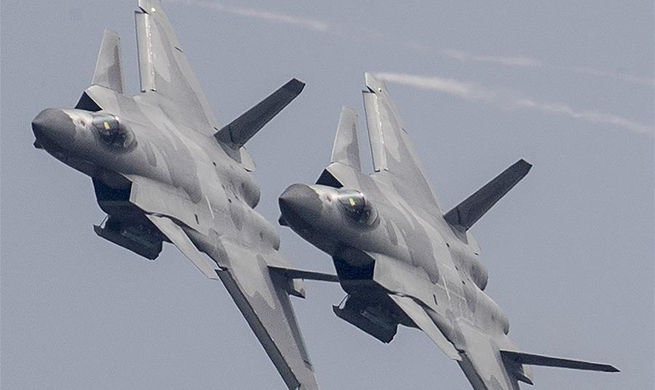HOUSTON, Nov. 11 (Xinhua) -- Oil prices dropped again after the fourth-week loss. The price of West Texas Intermediate (WTI) for December delivery and Brent crude for December delivery lost 4.7 percent and 3.6 percent, respectively, during the week ending Nov. 9.
In the previous week ending Nov. 2, WTI and Brent lost 6.6 percent and 6.2 percent, respectively, and WTI and Brent settled at 63.14 U.S. dollars and 72.83 dollars per barrel, respectively, at the end of the week.
On Monday, oil prices dipped slightly as Washington's sanctions against Iran and waivers from the sanctions came into force on this day. WTI dropped 0.04 U.S. dollar to settle at 63.1 dollars a barrel, while Brent was up 0.34 dollar to close at 73.17 dollars a barrel.
The United States re-imposed sanctions against Iran's oil exports, which had been lifted under the landmark 2015 nuclear agreement to curtail Iran's nuclear program.
Tehran, in response, dismissed Washington as Iranian President Hassan Rouhani said in a TV speech that it will "proudly break the unjust sanctions" and continue to sell oil.
The sanctions lifted supply concerns and concerns over economic slowdown, which may curb fuel demand. Despite the sanctions against Iran, the supply of oil is ample as output from the world's top three producers - Russia, the United States and Saudi Arabia - is rising.
On Tuesday, oil prices declined as the United States allowed eight major importers to continue buying oil from Iran for 180 days despite its sanctions against the Middle East country. WTI dropped 0.89 U.S. dollar to settle at 62.21 dollars a barrel, while Brent was down 1.04 dollars to close at 72.13 dollars a barrel.
Analysts said the continued high output of U.S. shale oil and the scheduled outage of U.S. refineries lately had increased crude storage levels, leading to the continued weakness of WTI price.
Washington has granted 180-day waivers to Iran's eight biggest buyers, who imported over 80 percent of Iran's oil exports last year. Analysts believed the exemptions relieved concerns over volatility in global market caused by U.S. sanctions against Iran.
Analysts estimate Iran's oil exports have fallen since U.S. President Donald Trump said in May he would re-impose sanctions, but exemptions could allow exports to rise again after November.
However, worries over excessive supply from the world's major oil producers still persist, as Russia, the United States and Saudi Arabia collectively produced more than 33 million barrels per day for the first time in October, amounting to more than one third of the world's almost 100 million barrels per day of crude oil consumption.
On Wednesday, oil prices decreased as U.S. crude inventories recorded a seventh consecutive increase. WTI dropped 0.54 dollar to settle at 61.67 dollars a barrel, and Brent was down 0.06 dollar to close at 72.07 dollars a barrel.
U.S. crude oil stockpiles in the week ending Nov. 2 increased by 5.8 million barrels, or about 3 percent above the five-year average for this time of year, according to the U.S. Energy Information Administration (EIA).
U.S. gasoline inventories increased by 1.9 million barrels, while distillate fuel inventories decreased by 3.5 million barrels, EIA said.
U.S. crude oil imports averaged 7.5 million barrels per day in the week, up by 195,000 barrels per day from the previous week. U.S. crude oil exports averaged 2.4 million barrels per day, down by 80,000 barrels per day from the previous week.
Concerns still permeated the global market that the rising oil inventories would lead to supply surplus, which seems to prompt major market players to take actions.
Russia and Saudi Arabia have reportedly started discussions over the potential output cuts in 2019. Moreover, the Organization of the Petroleum Exporting Countries (OPEC) is reportedly considering cutting oil productions again next year following the output curbs issued in 2017.
EIA's November Short Term Energy Outlook's estimate of production from OPEC for 2018 and 2019 was revised up by 60,000 barrels per day to 39.1 million barrels per day and 40,000 barrels per day to 38.8 million barrels per day, respectively.
U.S. crude oil production increased at a faster rate than EIA previously anticipated, putting further downward pressure on crude oil prices. EIA estimated that U.S. crude oil production will average 10.9 million barrels per day in 2018 and 12.1 million barrels per day in 2019, an increase of 160,000 barrels per day and 300,000 barrels per day, respectively.
On Thursday, oil prices fell as the global market has remained bearish following October's downturn amid worries of potential supply glut from world's major oil producers. WTI dropped 1 dollar to settle at 60.67 dollars a barrel, while Brent was down 1.42 dollars to close at 70.65 dollars a barrel.
Meanwhile, investors' sentiment is clouded by uncertainty over how oil demand would develop, as some industry insiders predicted deteriorating demand.
On Friday, oil prices extended further losses as U.S. crude has entered a "bear market territory" due to lingering concerns over excessive supply and shrinking demand. WTI dropped 0.48 dollar to settle at 60.19 dollars a barrel, while Brent was down 0.47 dollar to close at 70.18 dollars a barrel.
In the week ending Nov. 9, the number of active drilling rigs in the United States increased by 14 to 1,081, and the number of rigs operating in U.S. oil fields increased by 12 to 886.
The market will keep a close watch on the following U.S. oil inventories. From now on, U.S. sanctions on Iran are unlikely to cut supply as much as expected.
Meanwhile, the market will focus on the news of any meeting between officials from China and the United States aiming at seeking solution to the ongoing trade tensions.

















